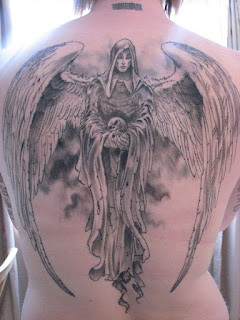Related posts:
Death tattoos: angels of death - themes and representations (1)
Death tattoos: angels of death - themes and representations (2)
Angel of Death tattoos: examples and ideas
Although Grim Reaper is the most common theme for the so-called death-tattoos, there are many people who choose a different representation of the Death: skeletons, demons, monsters, etc. One of the most popular choices is the "Angel of Death" theme.
The origin of the representations should be sought in the ancient religious texts (the Bible and the rabbinical literature). In these texts, there is no just one Angel of the Death.
Angel of the Death was created by God on the first day. He has twelve wings and is full of eyes. In the hour of death he stands at the head of the departing one with a drawn sword, to which clings a drop of gall. As soon as the dying man sees the angel, he is seized with a convulsion and opens his mouth, whereupon the angel throws the drop into it. ('Ab. Zarah 20b;) The expression "the taste of death" originated in the idea that death was caused by a drop of gall.
The Memitim - a type of angel from biblical lore associated with the mediation over the lives of the dying. The name is derived from the Hebrew word mĕmītǐm and refers to angels that brought about the destruction of those whom the guardian angels no longer protected.
Abaddon (The Destroyer) - in Revelation 9:7-11, Abaddon is described as "The Destroyer", "the Angel of the abyss", and as the king of a plague of locusts resembling horses with crowned human faces, women's hair, lions' teeth, wings, and the tail of a scorpion that torment people for five months. Abaddon is also called Apollyon.
Samael - a controversial figure who is an accuser, a seducer and a destroyer, and has been regarded as both good and evil. Sometimes he is a member of the heavenly host (with often grim and destructive duties), in the New Testament named Satan and the chief of the evil spirits. One of Samael's greatest roles in Jewish lore is that of the angel of death. He remains one of the Lord's servants even though he appears to want men to do evil. As a good angel, Samael resides in the seventh heaven, although he is declared to be the chief angel of the fifth heaven.
Sometimes Satan is identified as the Angel of Death. When the Messiah comes all the dead will arise, and there will be an end to death; for the angel of death himself will be destroyed by the Messiah. Satan, as the angel of death, is identified here with Antichrist. "The last enemy that shall be destroyed is death" (I Cor. xv. 26; compare Heb. ii. 14). The same idea seems to be expressed in the Book of Jubilees xxiii. 29: "And they shall fulfil all their days in peace and joy, and shall live on, since there will be no Satan and no evil to destroy them."
In the Roman Catholicism, the archangel Michael is viewed as the good Angel of Death (as opposed to Samael, the controversial Angel of Death), carrying the souls of the deceased to Heaven. There, he balances them in his scales (one of his symbols). He is said to give the dying souls the chance to redeem themselves before passing as well.
Other Angels of Death: Gabriel the Angel of Death over the kings; Ḳapẓiel over youths; Mashbir over animals; Mashḥit over children; Af and Ḥemah over man and beast.
Sometimes, there is no designated angel of death - death is viewed under form of an angel sent from God, a being deprived of all voluntary power. The "angel of the Lord" smites 185,000 men in the Assyrian camp (II Kings xix. 35). "The destroyer" ("ha-mashḥit") kills the first-born of the Egyptians (Ex. xii. 23), and the "destroying angel" ("mal'ak ha-mashḥit") rages among the people in Jerusalem (II Sam. xxiv. 15). In I Chron. xxi. 15 the "angel of the Lord" is seen by David standing "between the earth and the heaven, having a drawn sword in his hand stretched out over Jerusalem."




No comments:
Post a Comment